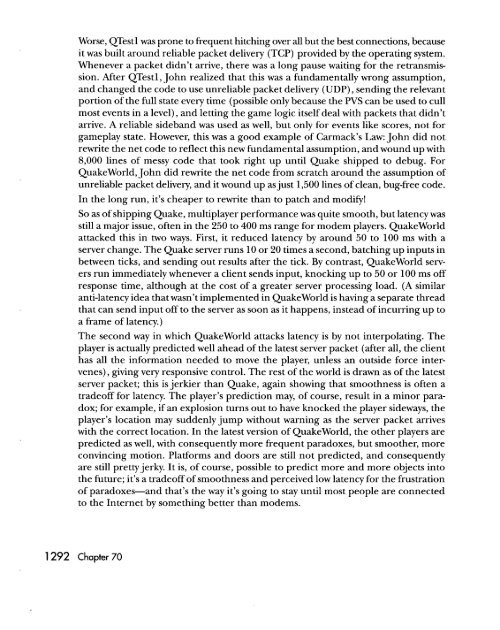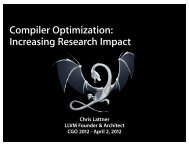quake: a post-mortem and a glimpse into the future
quake: a post-mortem and a glimpse into the future
quake: a post-mortem and a glimpse into the future
Create successful ePaper yourself
Turn your PDF publications into a flip-book with our unique Google optimized e-Paper software.
Worse, QTestl was prone to frequent hitching over all but <strong>the</strong> best connections, because<br />
it was built around reliable packet delivery (TCP) provided by <strong>the</strong> operating system.<br />
Whenever a packet didn’t arrive, <strong>the</strong>re was a long pause waiting for <strong>the</strong> retransmission.<br />
After QTestl, John realized that this was a fundamentally wrong assumption,<br />
<strong>and</strong> changed <strong>the</strong> code to use unreliable packet delivery (UDP), sending <strong>the</strong> relevant<br />
portion of <strong>the</strong> full state every time (possible only because <strong>the</strong> PVS can be used to cull<br />
most events in a level), <strong>and</strong> letting <strong>the</strong> game logic itself deal with packets that didn’t<br />
arrive. A reliable sideb<strong>and</strong> was used as well, but only for events like scores, not for<br />
gameplay state. However, this was a good example of Carmack’s Law: John did not<br />
rewrite <strong>the</strong> net code to reflect this new fundamental assumption, <strong>and</strong> wound up with<br />
8,000 lines of messy code that took right up until Quake shipped to debug. For<br />
Quakeworld, John did rewrite <strong>the</strong> net code from scratch around <strong>the</strong> assumption of<br />
unreliable packet delivery, <strong>and</strong> it wound up as just 1,500 lines of clean, bug-free code.<br />
In <strong>the</strong> long run, it’s cheaper to rewrite than to patch <strong>and</strong> modify!<br />
So as of shipping Quake, multiplayer performance was quite smooth, but latencywas<br />
still a major issue, often in <strong>the</strong> 250 to 400 ms range for modem players. Quakeworld<br />
attacked this in two ways. First, it reduced latency by around 50 to 100 ms with a<br />
server change. The Quake server runs 10 or 20 times a second, batching up inputs in<br />
between ticks, <strong>and</strong> sending out results after <strong>the</strong> tick. By contrast, Quakeworld servers<br />
run immediately whenever a client sends input, knocking up to 50 or 100 ms off<br />
response time, although at <strong>the</strong> cost of a greater server processing load. (A similar<br />
anti-latency idea that wasn’t implemented in Quakeworld is having a separate thread<br />
that can send input off to <strong>the</strong> server as soon as it happens, instead of incurring up to<br />
a frame of latency.)<br />
The second way in which Quakeworld attacks latency is by not interpolating. The<br />
player is actually predicted well ahead of <strong>the</strong> latest server packet (after all, <strong>the</strong> client<br />
has all <strong>the</strong> information needed to move <strong>the</strong> player, unless an outside force intervenes),<br />
giving very responsive control. The rest of <strong>the</strong> world is drawn as of <strong>the</strong> latest<br />
server packet; this is jerkier than Quake, again showing that smoothness is often a<br />
tradeoff for latency. The player’s prediction may, of course, result in a minor paradox;<br />
for example, if an explosion turns out to have knocked <strong>the</strong> player sideways, <strong>the</strong><br />
player’s location may suddenly jump without warning as <strong>the</strong> server packet arrives<br />
with <strong>the</strong> correct location. In <strong>the</strong> latest version of Quakeworld, <strong>the</strong> o<strong>the</strong>r players are<br />
predicted as well, with consequently more frequent paradoxes, but smoo<strong>the</strong>r, more<br />
convincing motion. Platforms <strong>and</strong> doors are still not predicted, <strong>and</strong> consequently<br />
are still pretty jerky. It is, of course, possible to predict more <strong>and</strong> more objects <strong>into</strong><br />
<strong>the</strong> <strong>future</strong>; it’s a tradeoff of smoothness <strong>and</strong> perceived low latency for <strong>the</strong> frustration<br />
of paradoxes-<strong>and</strong> that’s <strong>the</strong> way it’s going to stay until most people are connected<br />
to <strong>the</strong> Internet by something better than modems.<br />
1 292 Chapter 70

















